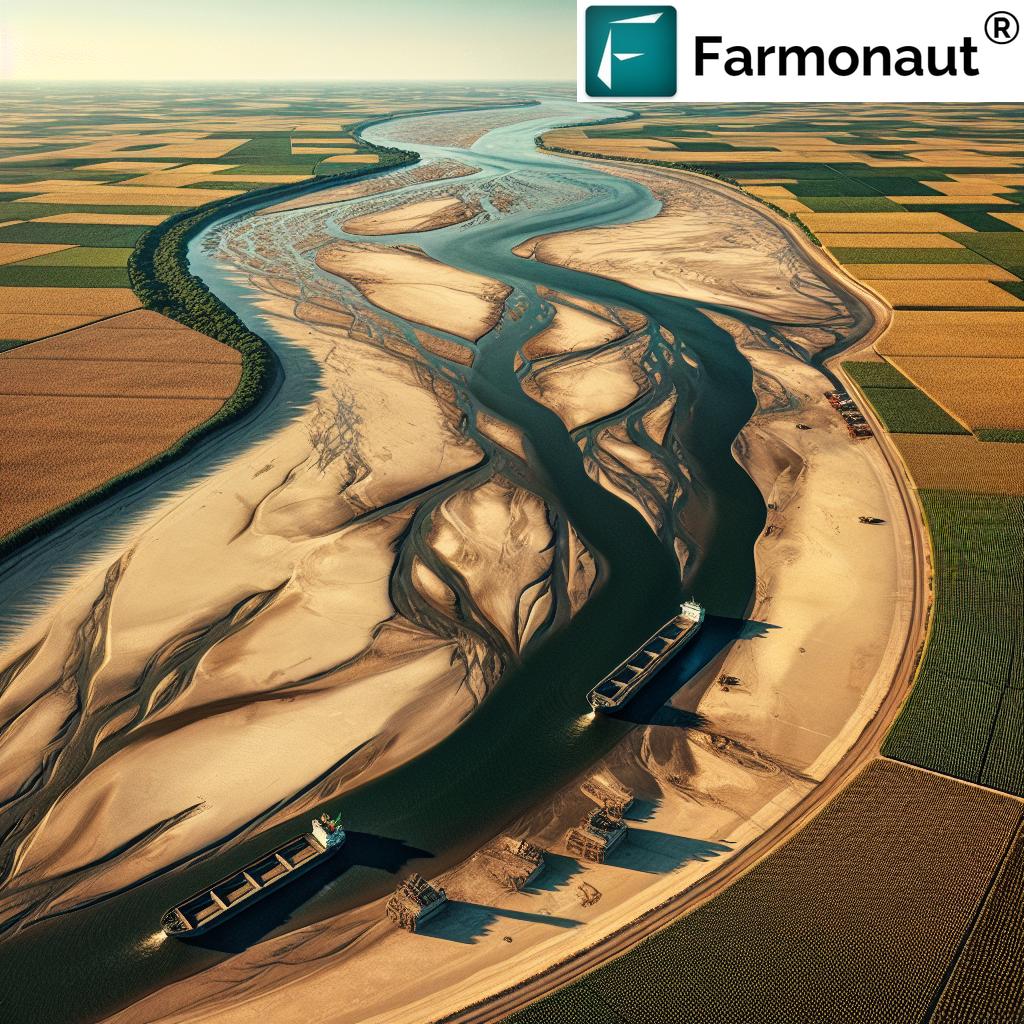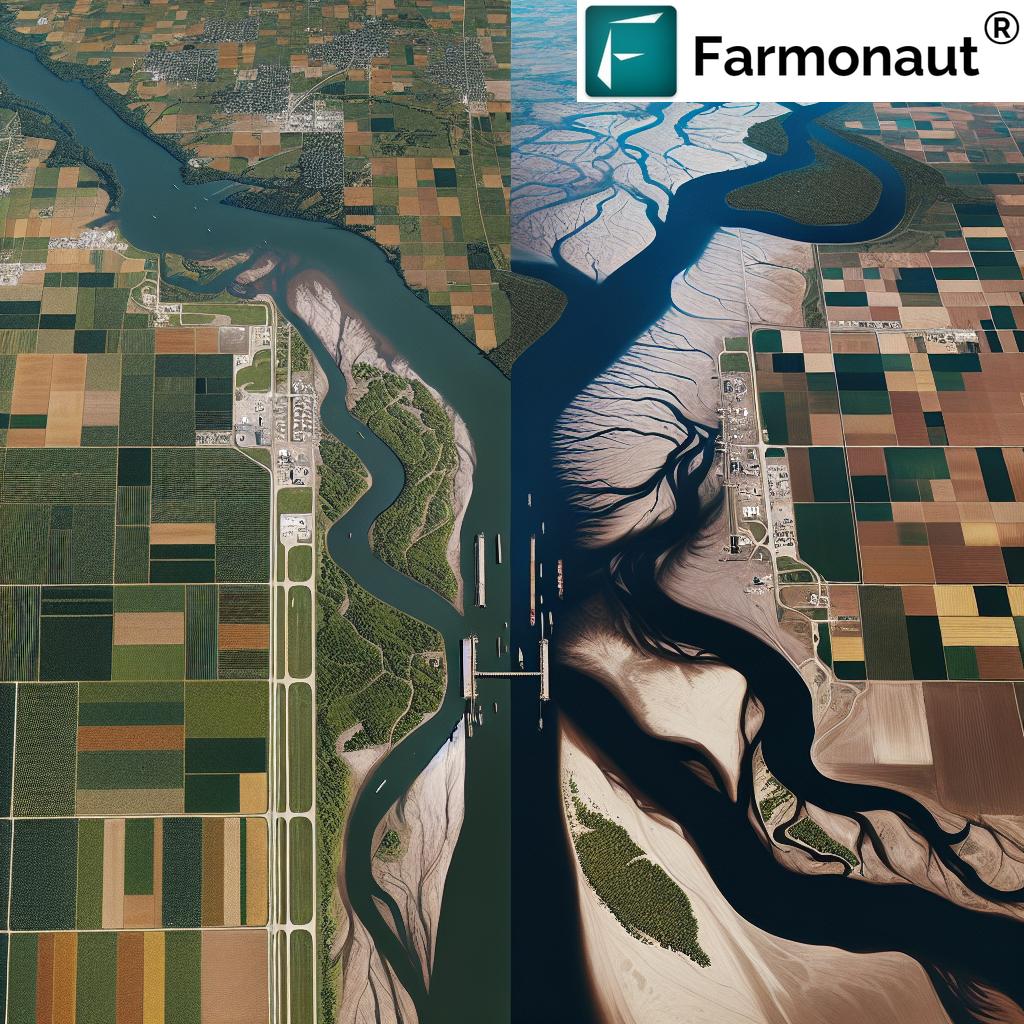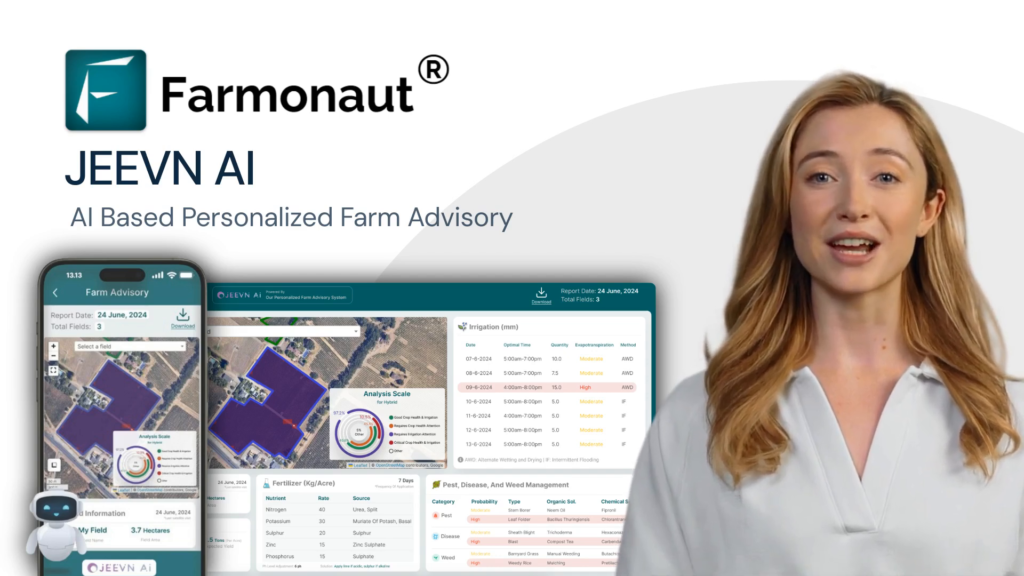Mississippi River’s Low Water Levels: Impact on Iowa Farmers and Crop Transportation in 2023
“In 2023, record-breaking corn and soybean yields were predicted despite the Mississippi River’s critically low water levels.”
“Many regions along the Mississippi River faced moderate to exceptional drought, impacting multiple aspects of farming and transportation.”

As we delve into the complex interplay between the Mississippi River’s water levels and Iowa’s agricultural landscape in 2023, we find ourselves navigating a challenging terrain of environmental, economic, and logistical factors. The Mississippi River, a vital artery for the United States’ agricultural trade, has been experiencing critically low water levels, posing significant challenges for farmers and barge transportation. This situation has far-reaching implications for crop production, transportation efficiency, and the global food supply chain.
The Mississippi River: A Lifeline for Agriculture
The Mississippi River serves as a crucial waterway for transporting agricultural products, particularly grains like corn and soybeans, from the heartland of America to international markets. Its extensive network of locks and dams facilitates the movement of barges, which are instrumental in the efficient and cost-effective transportation of bulk commodities. However, the river’s current state presents a complex challenge for the agricultural sector, especially in Iowa and the broader Midwest region.
Drought Conditions and Their Impact
In 2023, many areas along the Mississippi River watershed experienced moderate to exceptional drought conditions. This has led to significantly lower water levels in various sections of the river, affecting its navigability and the capacity of barges to transport goods efficiently. The drought’s impact extends beyond just water levels, influencing soil moisture, crop health, and overall agricultural productivity.
- Reduced Barge Capacity: Lower water levels force barges to carry lighter loads to avoid running aground, reducing transportation efficiency.
- Increased Transportation Costs: With reduced capacity, more trips are required to move the same amount of grain, driving up costs for farmers and traders.
- Delays in Shipping: Slower river traffic and potential bottlenecks at key points along the river can cause significant delays in getting crops to market.
At Farmonaut, we recognize the critical nature of these challenges. Our satellite-based crop monitoring technology provides valuable insights into drought conditions and their effects on crop health, helping farmers make informed decisions in these challenging times.
Iowa’s Agricultural Landscape in 2023
Iowa, known for its significant corn and soybean production, finds itself at the epicenter of these challenges. Despite the drought conditions, 2023 saw predictions of record-breaking yields for both corn and soybeans in the state. This paradoxical situation creates a unique set of challenges:
- High Yield, Low Water: While crop production remains strong, the ability to transport these crops efficiently is compromised.
- Storage Concerns: With potential delays in transportation, farmers may face issues with storage capacity and quality maintenance of harvested crops.
- Market Price Fluctuations: The interplay between high yields and transportation challenges could lead to localized price variations for crops.
Farmonaut’s advanced satellite imagery and AI-driven analysis help farmers monitor their crop health in real-time, enabling them to optimize their production strategies even in the face of these environmental challenges.
Navigation Infrastructure and Barge Transportation
The Mississippi River’s navigation infrastructure, including its system of locks and dams, plays a crucial role in facilitating barge transportation. However, the current low water levels are putting this infrastructure to the test:
- Reduced Draft Depths: Lower water levels mean shallower draft depths, limiting the size and weight of barges that can navigate safely.
- Increased Risk of Groundings: Barges face a higher risk of running aground, particularly in areas where the river bottom may have shifted due to changing water levels.
- Congestion at Locks: With more frequent and lighter barge loads, there’s increased traffic at locks, potentially causing delays.
These challenges in navigation infrastructure directly impact the efficiency of grain export trends, a critical factor for Iowa farmers and the broader agricultural economy.
Crop Production Forecasts and Agricultural Trade
Despite the challenges posed by the Mississippi River’s low water levels, crop production forecasts for Iowa and the Midwest remain optimistic. This creates a unique situation where high yields meet logistical hurdles:
- Corn Production: Iowa’s corn crop is expected to see record yields, contributing significantly to the national corn production.
- Soybean Outlook: Similarly, soybean production is forecasted to be robust, maintaining Iowa’s position as a leading soybean producer.
- Export Challenges: While production is high, the ability to efficiently export these crops faces significant challenges due to transportation issues on the Mississippi River.
At Farmonaut, our satellite-based crop area estimation tools provide valuable data for accurately forecasting crop production, helping stakeholders in the agricultural sector make informed decisions.
Explore Farmonaut’s API for detailed agricultural insights

Impact on Farm Economics and Global Food Supply Chains
The current situation on the Mississippi River has far-reaching implications for farm economics and global food supply chains:
- Increased Transportation Costs: Higher costs for barge transportation are likely to be passed on to farmers, potentially reducing their profit margins.
- Market Access Challenges: Delays in transportation could affect farmers’ ability to take advantage of optimal market conditions for their crops.
- Global Supply Chain Disruptions: As a major exporter of corn and soybeans, any disruption in the U.S. grain transportation system can have ripple effects on global food supply chains.
Farmonaut’s blockchain-based traceability solutions offer enhanced transparency in these complex supply chains, providing valuable information for all stakeholders from farm to consumer.
Monitoring River Stages and Agricultural Impact
Continuous monitoring of the Mississippi River’s water levels is crucial for understanding and mitigating the impact on agriculture. Key monitoring points include:
- Dubuque, IA: An important gauge for monitoring the upper Mississippi River’s conditions.
- Memphis, TN: Provides insights into the river’s state further downstream, crucial for understanding the full extent of transportation challenges.
These gage readings offer valuable data on water levels, helping to predict potential challenges for barge transportation and informing decisions on crop movement strategies.
Adapting to Changing Conditions
Farmers and agricultural businesses in Iowa and the Midwest are adapting to these challenging conditions in several ways:
- Alternative Transportation Methods: Exploring options like rail and truck transport to supplement barge transportation.
- Strategic Crop Storage: Implementing improved storage solutions to maintain crop quality during potential transportation delays.
- Market Diversification: Seeking alternative markets or value-added opportunities for crops that may face export challenges.
Farmonaut’s AI-driven advisory system, Jeevn AI, provides personalized recommendations to farmers, helping them navigate these complex decisions and adapt their strategies to changing conditions.
Access Farmonaut’s API Developer Docs for in-depth agricultural data
Looking Ahead: Implications for 2024 and Beyond
As we look towards 2024 and beyond, several factors will continue to influence the interplay between the Mississippi River’s water levels and agricultural productivity:
- Climate Change Impacts: Ongoing climate changes may lead to more frequent and severe drought conditions, potentially affecting river levels and agricultural production.
- Infrastructure Investments: Potential investments in river infrastructure and dredging operations could help mitigate some of the challenges posed by low water levels.
- Technological Advancements: Continued development of agricultural technologies, like those offered by Farmonaut, will play a crucial role in helping farmers adapt to changing conditions.
Farmonaut’s commitment to innovative agricultural solutions positions us at the forefront of addressing these ongoing challenges, providing farmers with the tools they need to thrive in an ever-changing agricultural landscape.
The Broader Impact on Rural Communities
The challenges faced by farmers due to the Mississippi River’s low water levels extend beyond the farm gate, impacting entire rural communities in Iowa and the Midwest:
- Economic Ripple Effects: Reduced farm incomes can lead to decreased spending in local economies, affecting businesses throughout rural areas.
- Employment Concerns: Challenges in the agricultural sector can impact employment in related industries, from transportation to agricultural processing.
- Community Resilience: The ability of rural communities to adapt to these challenges will be crucial for their long-term viability.
Farmonaut’s solutions not only benefit individual farmers but also contribute to the overall resilience of rural communities by supporting sustainable and efficient agricultural practices.
The Role of Technology in Navigating Challenges
In the face of these complex challenges, technology plays a crucial role in helping farmers and agricultural businesses adapt and thrive:
- Satellite-Based Monitoring: Advanced satellite imagery, like that used by Farmonaut, provides real-time insights into crop health and field conditions.
- AI-Driven Decision Support: Artificial intelligence algorithms can analyze vast amounts of data to provide actionable insights for farm management.
- Precision Agriculture: Technologies that enable precise application of inputs can help farmers optimize resource use, particularly important during drought conditions.
Farmonaut’s suite of technologies, including our satellite-based crop monitoring and AI advisory systems, are at the forefront of this technological revolution in agriculture.
International Trade Implications
The challenges faced by Iowa farmers and the broader U.S. agricultural sector due to the Mississippi River’s low water levels have significant implications for international trade:
- Global Market Dynamics: Delays or reductions in U.S. grain exports can affect global grain prices and availability.
- Trade Relationships: Consistent supply challenges could potentially impact long-term trade relationships and agreements.
- Competitive Positioning: Other grain-exporting countries may seek to fill gaps in the market created by U.S. export challenges.
Farmonaut’s global perspective and data-driven insights help stakeholders in the agricultural sector understand and navigate these complex international trade dynamics.
Mississippi River Gage Readings and Agricultural Impact
| Location | Current Water Level (ft) | Normal Water Level (ft) | Deviation from Normal (%) | Impact on Barge Traffic | Estimated Crop Transportation Delay (days) | Affected Crops | Estimated Economic Impact ($ millions) |
|---|---|---|---|---|---|---|---|
| Iowa City, IA | 8.2 | 12.5 | -34.4% | High | 7-10 | Corn, Soybeans | 50-75 |
| Davenport, IA | 6.8 | 11.0 | -38.2% | High | 8-12 | Corn, Soybeans | 60-90 |
| Dubuque, IA | 7.5 | 12.0 | -37.5% | High | 7-11 | Corn, Soybeans | 55-80 |
| Keokuk, IA | 5.9 | 10.5 | -43.8% | Very High | 10-14 | Corn, Soybeans | 70-100 |
| Memphis, TN | -7.2 | 5.0 | -244% | Extreme | 14-21 | Corn, Soybeans, Cotton | 100-150 |
Conclusion: Navigating Uncertain Waters
The challenges posed by the Mississippi River’s low water levels in 2023 have created a complex scenario for Iowa farmers and the broader agricultural sector. While record-breaking yields offer promise, the logistical hurdles presented by the river’s condition threaten to disrupt the efficient movement of crops to market. This situation underscores the intricate relationship between natural resources, agricultural productivity, and global trade dynamics.
As we move forward, the resilience and adaptability of farmers, coupled with technological innovations and strategic planning, will be crucial in navigating these challenges. Farmonaut remains committed to providing cutting-edge solutions that empower farmers and agricultural stakeholders with the insights and tools they need to thrive in an ever-changing landscape.
By leveraging advanced technologies like satellite monitoring, AI-driven analytics, and blockchain-based traceability, we can work towards a more resilient and sustainable agricultural future. As the situation continues to evolve, staying informed and adaptable will be key to overcoming the challenges posed by the Mississippi River’s low water levels and ensuring the continued success of Iowa’s agricultural sector.
FAQ Section
- Q: How do low water levels in the Mississippi River affect crop transportation?
A: Low water levels reduce barge capacity, increase transportation costs, and cause shipping delays, making it challenging to move crops efficiently to market. - Q: What crops are most affected by the Mississippi River’s low water levels in Iowa?
A: Corn and soybeans, Iowa’s primary crops, are the most affected due to their reliance on river transportation for export. - Q: How are farmers adapting to these transportation challenges?
A: Farmers are exploring alternative transportation methods, improving crop storage solutions, and seeking diverse market opportunities to mitigate the impact of river transportation issues. - Q: What role does technology play in addressing these agricultural challenges?
A: Technologies like satellite-based crop monitoring, AI-driven advisory systems, and precision agriculture tools help farmers make informed decisions and optimize their operations despite environmental challenges. - Q: How might the current situation impact global food supply chains?
A: Delays and increased costs in U.S. grain exports can affect global grain prices and availability, potentially disrupting international food supply chains and trade relationships.
















